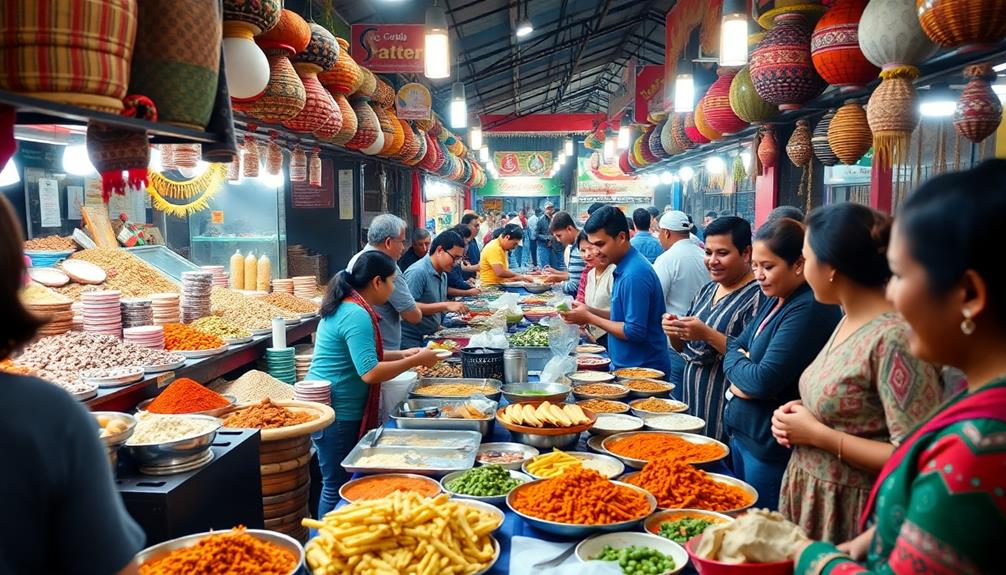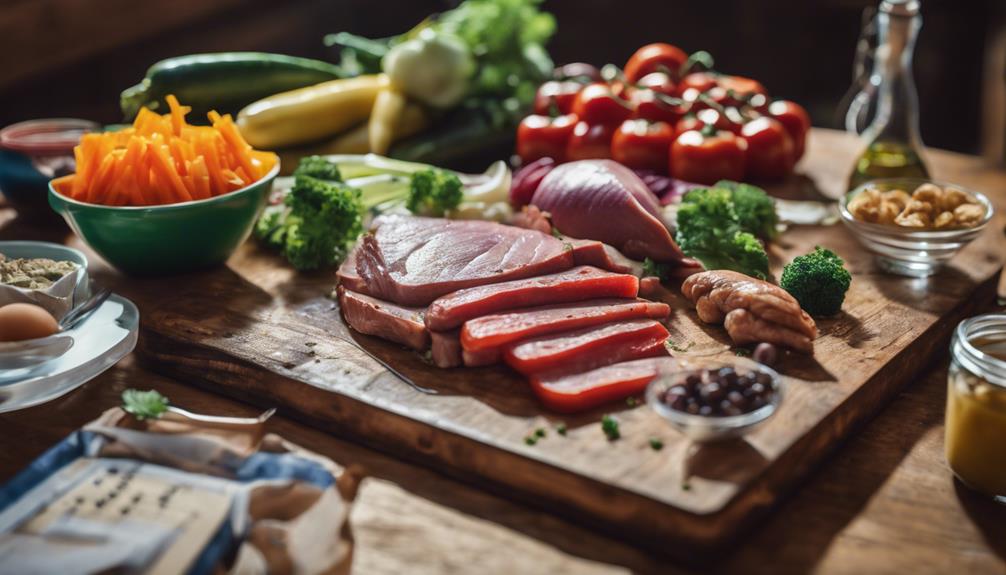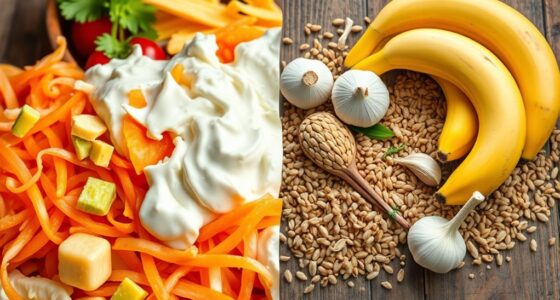Cultural identity shapes your food preferences in profound ways. The flavors you crave often reflect your background and traditions. Traditional dishes bring comfort, connecting you to family gatherings and celebrations. As you encounter new culinary trends, you may blend them with your homeland's flavors. Foods tied to religious practices or cultural rituals also play a significant role in your choices. Whether enjoying communal meals or favorite snacks, these experiences reinforce your identity. Understanding this connection helps you appreciate the rich symbolism and practices behind the dishes you love, revealing even more insights into how culture influences cuisine.
Key Takeaways
- Cultural identity significantly influences food choices, reflecting traditions and familial connections tied to specific dishes and culinary practices.
- Traditional foods often serve as comfort food, evoking nostalgia and reinforcing cultural ties during holidays and family gatherings.
- Ethnic groups exhibit distinct eating patterns, with Hispanic and Asian consumers favoring heritage foods that resonate with their cultural backgrounds.
- Snacks provide accessible connections to cultural traditions, allowing consumers to explore global flavors and share experiences at social gatherings.
- Dietary practices are shaped by religious beliefs, impacting food choices and emphasizing the role of food in spiritual and cultural identity.
Cultural Influence on Food Choices
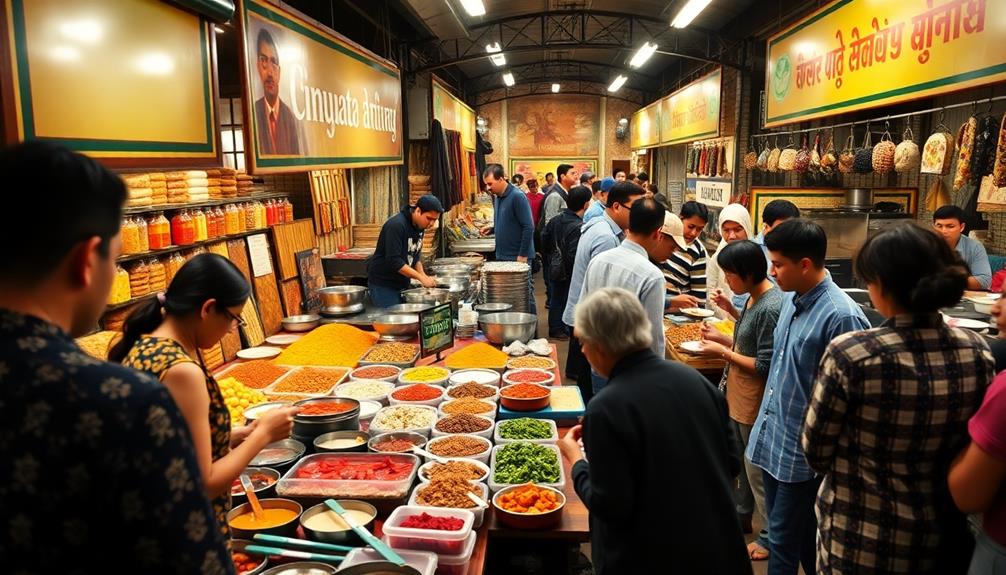
Cultural backgrounds shape your food choices in profound ways. Your culinary traditions and preferences often reflect your cultural identity, guiding you toward flavors and dishes that resonate with your heritage. For instance, when you think of comfort food, it's likely tied to traditional foods that remind you of family gatherings or special occasions, such as the vibrant dishes found in Brazilian cuisine.
Recent immigrants frequently navigate a fascinating blend of food choices, embracing American culinary trends while holding on to the tastes of their homeland. This duality illustrates how cultural backgrounds enrich your diet and create a unique gastronomic experience.
For many Hispanic and Asian consumers, the connection to their cultural identity through food is particularly strong, often prioritizing dishes that embody their heritage.
As the U.S. becomes increasingly diverse, brands recognize the opportunity to celebrate and share global flavors, catering to a market that values authenticity. You may find yourself drawn to these offerings, as they not only satisfy your palate but also affirm your cultural roots.
Ultimately, your food choices serve as a delicious expression of who you're and where you come from, bridging the gap between tradition and modernity.
Ethnic Group Eating Patterns
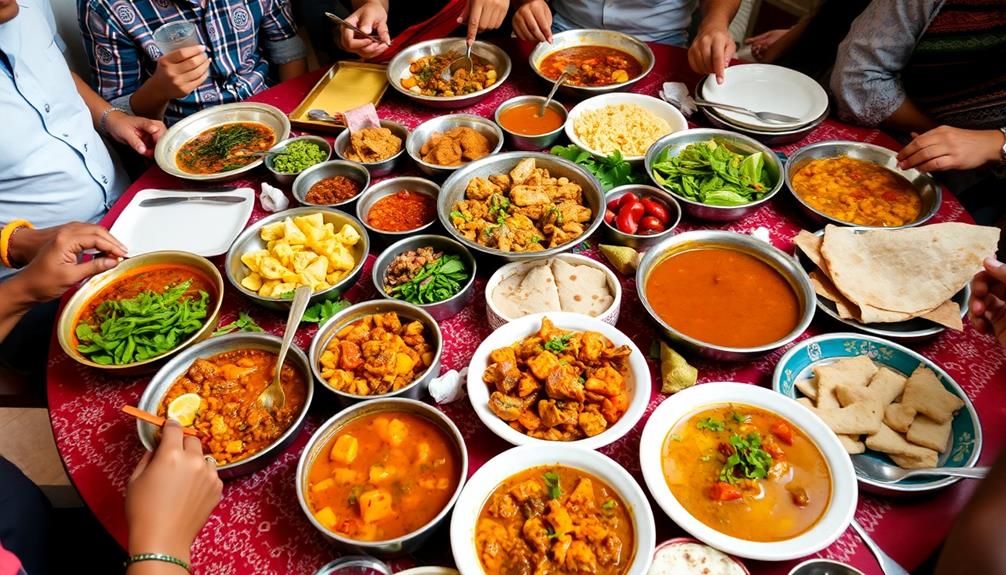
Eating patterns among different ethnic groups reflect a rich tapestry of traditions and lifestyles. Your food traditions are often influenced by cultural identities, shaping how you approach mealtime.
For instance, Hispanic and Asian consumers tend to favor traditional food that resonates with their heritage, valuing flavors that connect them to their roots. In African cuisine, dishes like Muamba De Galinha highlight the importance of communal dining and cultural significance, often featuring rich flavors and key ingredients that resonate with heritage.
Meanwhile, socioeconomic factors play a significant role in ethnic group eating patterns. You might notice that African Americans often face challenges in preparing home-cooked meals and dining together, which can differ from Asian and White consumers who prioritize nutrition and convenience. This emphasis on quick and nutritious options aligns with the busy lifestyles many Asian consumers lead.
Although snacking behaviors show some similarities across ethnic groups, mealtime rituals and preferences highlight the diversity of food consumption practices. Traditional foods often take center stage during holidays and special occasions, reinforcing cultural ties and the significance of shared meals within your community.
Snacks as Cultural Connections

Food preferences go beyond main meals, extending into the domain of snacks that reflect cultural identities. Snacks often serve as quick access points to cultural traditions, allowing you to incorporate your heritage into everyday eating habits.
For instance, enjoying items like elote can evoke memories of summer street fairs, while chilaquiles might remind one of leisurely weekend breakfasts with family. They can create moments of cultural exploration and sharing, fostering connections among individuals from different backgrounds.
Here are some ways snacks connect to cultural identity:
- Nostalgia: You might choose snacks that remind you of your upbringing or family traditions, bringing comfort and familiarity.
- Fusion: Many snacks blend traditional flavors with contemporary presentations, showcasing how culinary arts can evolve while honoring heritage.
- Diversity: The increasing variety of snacks in the U.S. reflects the growing cultural diversity, highlighting global flavors and unique ingredients.
- Food Experiences: Sharing snacks from different cultures can enhance your social gatherings, turning simple moments into rich food experiences.
Market Trends in Global Cuisine
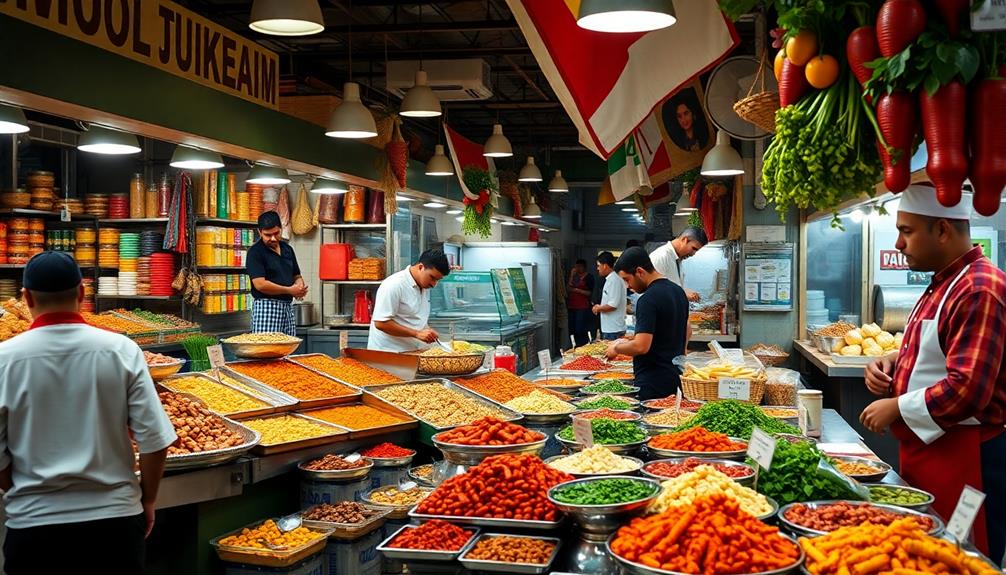
You'll notice that evolving flavor profiles are shaping the way we experience global cuisine today.
Traditional dishes like Kue Putu and Dadar Gulung showcase how cultural elements infuse unique tastes into familiar recipes.
As cultural fusion trends emerge, they offer exciting opportunities to explore familiar tastes in new and innovative ways.
This shift not only reflects your diverse culinary preferences but also highlights the growing connection between food and cultural identity.
Evolving Flavor Profiles
As the US population becomes increasingly diverse, a wave of evolving flavor profiles is reshaping the culinary landscape.
You're likely noticing a shift in your food choices, with more consumers enthusiastic to explore global cuisines that reflect their cultural traditions. Indian dishes, such as Mushroom Masala, have garnered attention for their rich blends of spices and vegetarian-friendly options.
Here are some trends you might find intriguing:
- Authenticity: Nearly 40% of Americans want genuine international flavors that connect to their heritage.
- Crossover Flavors: Fusion cuisine is on the rise, blending traditional tastes with modern cooking styles, like Asian spices in classic American dishes.
- Cultural Connection: Hispanic and Asian consumers actively seek food products that resonate with their identities, leading brands to authentically represent these flavors.
- Snack Revolution: Snack foods are becoming a key platform for cultural exploration, allowing you to quickly connect with your roots or discover new global tastes.
This evolving landscape reflects a broader interest in food that's not just about eating, but also about sharing experiences and embracing diversity.
As you plunge into these emerging flavors, you're part of a movement that celebrates cultural identity through culinary innovation.
Cultural Fusion Trends
The growing enthusiasm for diverse culinary experiences is driving cultural fusion trends in the food market. With 54% of consumers keen to try foods from different cultures, it's clear that fusion cuisines, like Korean tacos and sushi burritos, are reshaping how we view traditional dishes.
Innovative combinations, such as the incorporation of traditional Japanese treats like dorayaki and umeboshi, not only satisfy your taste buds but also spark curiosity and cultural exploration.
A 2022 report shows that ethnic food sales in the U.S. hit approximately $20.6 billion, highlighting the immense potential for brands that embrace global flavors.
You'll find that food brands authentically incorporating cultural elements, such as Saffron Road's halal-certified meals, are experiencing increased consumer engagement and loyalty. This engagement isn't just about taste; it's about connecting with a broader narrative that resonates with today's diverse consumers.
Ultimately, these cultural fusion trends are more than just culinary novelties. They create opportunities for brands to thrive in an evolving market landscape, where the fusion of flavors and cooking techniques enhances your dining experience.
As you explore these exciting options, you'll discover how food can serve as a bridge across cultures, making every meal a journey.
Consumer Behavior Insights
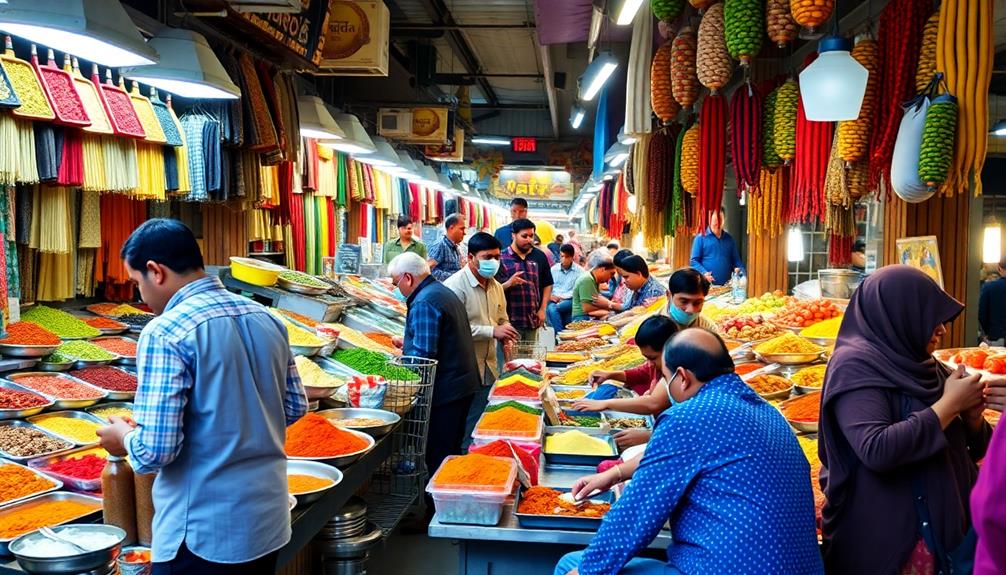
Understanding consumer behavior in relation to cultural identity reveals how deeply food preferences are shaped by individual backgrounds. For instance, dishes like bulgogi and kimchi often resonate with Korean consumers, reflecting their cultural heritage while also appealing to a broader audience.
Here are some insights into how culture influences your choices:
- Cultural Ties: Hispanic and Asian consumers often gravitate towards foods that reflect their heritage while also incorporating American values.
- Mealtime Habits: You might notice distinct differences in mealtime habits and nutritional choices across ethnic groups, particularly among Asian, White, and African American consumers.
- Market Opportunities: With the growing diversity in the U.S., brands like Saffron Road and Brazi Bites leverage authentic cultural foods to attract diverse consumer bases.
- Cultural Engagement: Food serves as an essential means of cultural engagement, showcasing broader social narratives, gender roles, and community connections.
Religion's Role in Food Practices

Religion greatly influences your food choices, shaping dietary restrictions and beliefs that guide what you eat.
For instance, during Ramadan, many Muslims enjoy special dishes like Qatayef (Sweet Dumplings) as part of their celebrations, showcasing the rich culinary traditions tied to their faith.
Celebrations and rituals tied to these practices, like Passover or Ramadan, offer a unique way to connect with your faith and community.
Understanding these customs can deepen your appreciation for the cultural identity that food embodies.
Dietary Restrictions and Beliefs
Dietary restrictions often reflect deep-rooted beliefs that shape individual and communal identities.
You might find that these restrictions aren't just about food but are intertwined with spiritual health and cultural identity.
For instance, Italian cuisine showcases a rich diversity, where dishes like Agnolotti and Pasta Alla Norma may be adapted to meet various dietary needs while maintaining cultural significance.
Here are some key points to contemplate:
- Islam: Fasting during Ramadan emphasizes self-discipline and spiritual reflection.
- Judaism: Kashrut outlines kosher laws, promoting adherence to religious guidelines and spiritual well-being.
- Eastern Religions: Buddhism, Hinduism, and Jainism encourage vegetarianism, aligning food habits with principles of non-violence.
- Diversity Within Beliefs: Variations in dietary practices can exist within the same religion, influenced by different interpretations of texts.
Rituals and Celebrations
Throughout various cultures, food often becomes a central element in rituals and celebrations, serving as a bridge between the spiritual and the communal. For instance, during Ramadan, food plays a crucial role as Muslims break their fast together, emphasizing community bonding through shared meals after sunset.
Similarly, Jewish dietary laws, known as kosher, dictate specific practices that enhance spiritual health and reinforce community identity. In Ethiopian culture, traditional beverages like Tella (Traditional Beer) and Tej (Honey Wine) are integral to celebrations, highlighting the importance of food in communal gatherings.
In traditions like Buddhism, Hinduism, and Jainism, vegetarianism arises from cultural beliefs centered on non-violence, showcasing compassion for all living beings.
Celebratory rituals also revolve around food; take the Passover Seder, for example. This meal not only commemorates historical events but fosters family unity through traditional dishes and storytelling, weaving personal narratives into the fabric of community life.
It's important to note that variations in dietary practices exist within the same religious group, highlighting diverse interpretations of sacred texts and cultural adaptations.
Whether it's differing approaches to fasting or feasting during religious holidays, these nuances reflect the rich tapestry of beliefs and traditions that shape our food preferences and communal experiences.
Food Etiquette Across Cultures
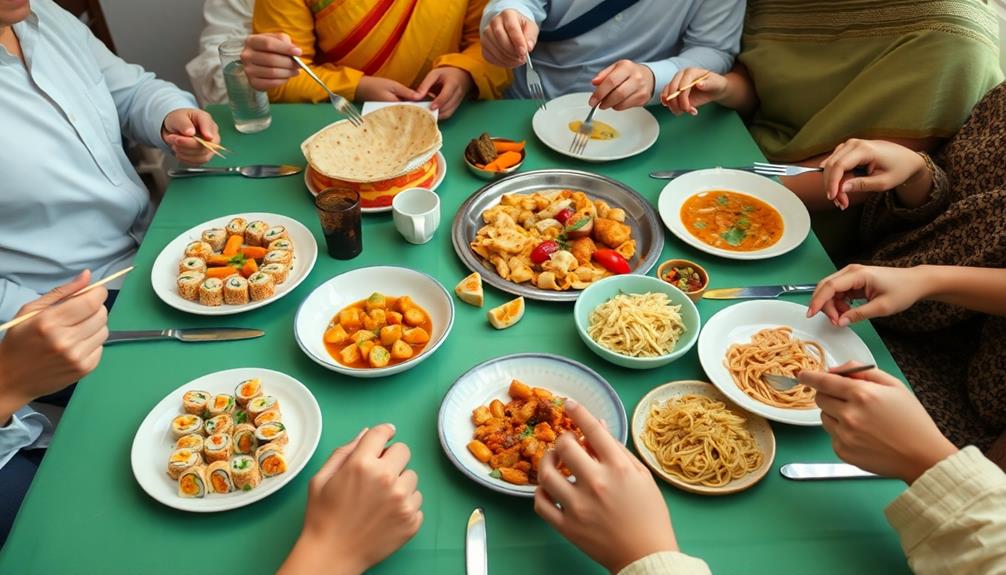
Food etiquette varies widely across cultures, often reflecting deep-rooted traditions and values. Understanding these cultural practices is essential for managing social interactions and appreciating diverse traditions.
Here are some key points to reflect on:
- Utensils vs. Fingers: Some cultures prefer using fingers for eating, while others opt for chopsticks or forks and knives, showcasing their unique culinary practices.
- Right Hand Rule: In many Middle Eastern cultures, eating with the right hand is customary, as the left hand is considered unclean.
- Formal Dining: Cultures like French and Japanese have strict etiquette rules regarding seating arrangements and structured courses, emphasizing manners and presentation.
- Communal Eating: Countries such as Italy and Spain prioritize communal eating, where sharing dishes fosters social interactions and strengthens bonds among diners.
Symbolism in Culinary Traditions

Culinary traditions are rich with symbolism, serving as a vibrant tapestry that weaves together community, heritage, and identity. Each dish tells a story, reflecting cultural beliefs and societal values. Traditional foods often play an essential role in celebrations and rituals, reinforcing communal bonds during holidays and gatherings.
| Symbolic Dish | Cultural Significance | Associated Rituals |
|---|---|---|
| Challah | Represents spiritual health | Shabbat and Jewish holidays |
| Rice | Symbolizes prosperity | Weddings and harvest festivals |
| Tamales | Connects family heritage | Christmas and Day of the Dead |
The ingredients and preparation methods can embody specific cultural beliefs, such as kosher laws in Jewish cuisine. Sharing meals acts as a powerful symbol of unity and friendship. Think about the act of breaking bread, which signifies warmth and connection among people. Additionally, culinary practices often reveal social hierarchies, showcasing how food types can reflect socio-economic status, like rice's historical significance in Japan. Consequently, understanding these symbols in culinary traditions enhances your appreciation for diverse food cultures and their profound meanings.
Gender Dynamics in Food Culture

In many households, gender dynamics play an essential role in shaping food culture and practices. You might notice how these dynamics influence food preparation, eating behaviors, and the overall culinary experience. Here are some key points to reflect on:
- Division of Labor: Women often handle home cooking, while men dominate the commercial food sector.
- Eating Behaviors: Research shows women typically adopt more restrictive eating behaviors than men, influenced by societal norms surrounding health.
- Cultural Beliefs: Gender norms affect the types of foods prepared, with women prioritizing nutrition and well-being in family meals.
- Historical Context: The evolution of food practices, such as the shift of white rice in Japan, reveals underlying power dynamics between genders.
These gender dynamics not only affect who cooks but also the nutritional value and cultural significance of the meals prepared.
Understanding these roles can help you appreciate how deeply intertwined culinary practices are with cultural beliefs about femininity and masculinity. By recognizing these influences, you can navigate your own food preferences and practices with greater awareness and intention.
Frequently Asked Questions
How Does Culture Influence Food Preferences?
Culture influences your food preferences by shaping what you consider delicious, familiar, or comforting. It affects your choices, from daily meals to special occasions, as well as how you prepare and share food with others.
How Does Food Relate to Cultural Identity?
So, you think food's just fuel? Think again! It's a tasty passport to cultural identity. Each bite tells a story, connects you to your roots, and celebrates traditions, making every meal a delicious heritage lesson.
How Does Cultural and Family Background Shape Food Choices?
Your cultural and family background shapes your food choices by influencing the flavors you crave, the meals you prepare, and the traditions you uphold. These elements create a unique culinary identity that reflects your heritage and values.
What Are the Cultural Determinants of Food Choice?
Cultural determinants of food choice include traditions, religious beliefs, and community practices. You often find yourself influenced by family recipes, social gatherings, and the flavors that connect you to your heritage, shaping your culinary preferences. These cultural factors intertwine with individual personality traits and food choices, as your preferences may also be shaped by your openness to trying new cuisines or your tendency to stick with familiar flavors. For instance, an adventurous personality might lead you to explore diverse international dishes, while a cautious nature might anchor you to comfort foods from your upbringing. Ultimately, food choices become a reflection of both who you are and the cultural narratives that have influenced your journey.
Conclusion
In exploring how cultural identity shapes food preferences, you see the vibrant tapestry of our choices—traditions that guide us, memories that nourish us, and values that define us. You recognize how ethnic patterns influence your plate, how snacks connect you to your roots, and how market trends reflect your tastes. You appreciate the role of religion, the nuances of etiquette, and the symbolism in every dish, revealing that food is more than sustenance; it's a celebration of who you are.

